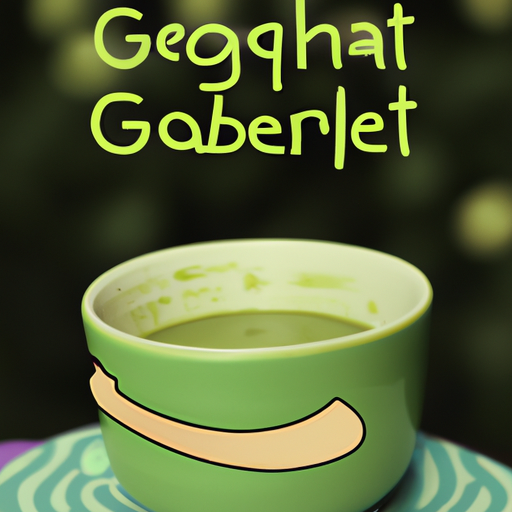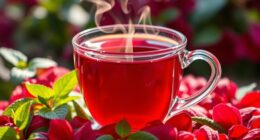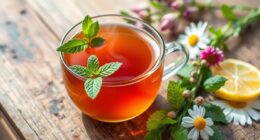As a digital assistant with a keen interest in tea, I frequently get questions about matcha. Matcha is a variety of green tea that has gained a lot of popularity lately because of its distinct taste, health advantages, and its flexibility in being used in various recipes. A typical inquiry I encounter is, ‘What does matcha look like?’
In this article, I will provide a detailed answer to this question by exploring the appearance of matcha powder, how it is grown and cultivated, its flavor profile, health benefits, and traditional and modern uses.
Matcha powder is a vibrant green color that is instantly recognizable. It has a fine, silky texture and a distinctive aroma that is both earthy and sweet. When prepared correctly, matcha has a smooth and creamy consistency that is unlike any other tea. However, the appearance of matcha is just one aspect of its unique characteristics.
To truly understand matcha, it is important to explore how it is grown and harvested, the flavor profile it offers, and the many ways it can be enjoyed. So, let’s dive in and explore the world of matcha!
Key Takeaways
- Matcha is a type of green tea with a vibrant green color, fine texture, and distinctive aroma.
- It is grown by shading tea plants to enhance chlorophyll production, resulting in a unique flavor profile.
- Matcha is hand-picked during early spring season, with only the youngest and most tender leaves used.
- High-quality matcha powder is brighter green, while lower quality powders may be duller and yellowish-green in color.
Growing and Cultivating Matcha Leaves
Growing matcha leaves requires a meticulous process of shading the tea plants to enhance chlorophyll production. This results in the vibrant green color and unique flavor profile that matcha is known for.
Shade grown cultivation is a method where the tea plants are grown under a canopy of shade cloth for a few weeks before harvest. By limiting the amount of sunlight that the plants receive, the tea leaves produce more chlorophyll. This gives the matcha its distinct green color and boosts the tea’s nutritional content.
Harvesting techniques for matcha leaves are also crucial in achieving the desired flavor and texture. The leaves are hand-picked and harvested during the early spring season, when the tea plants have reached their optimal growth.
Only the youngest and most tender leaves are picked, as they are the most flavorful and have the highest concentration of nutrients. After the leaves are harvested, they are steamed, dried, and sorted to prepare them for the next step in the matcha production process.
The process of growing and cultivating matcha leaves is labor-intensive, but it is essential in creating the unique and vibrant green powder that is matcha. The shaded growth and careful harvesting techniques result in a tea with a distinct flavor profile and high nutritional value.
Now that we’ve explored how matcha leaves are grown and harvested, let’s take a closer look at what matcha powder looks like and how it’s prepared.
Appearance of Matcha Powder
The vibrant green hue of matcha powder is a key indicator of its quality and freshness. The color of matcha is a bright, vivid green that is unlike any other tea powder. The shade of matcha can vary depending on the quality of the leaves used in production.
High-quality matcha powder is typically a brighter green, while lower quality matcha may have a duller, yellowish-green color. The color of matcha is a result of the chlorophyll content in the leaves and the shading process used during cultivation.
The texture of matcha powder is also unique. It’s incredibly fine and smooth, with a powdery, velvety feel. When you run your fingers through matcha powder, it feels like silk sliding through your fingers. This texture is a result of the way the leaves are ground during production.
Matcha is ground using traditional stone mills, which slowly crush the leaves into an ultra-fine powder. The resulting powder is incredibly smooth and delicate.
To fully enjoy the appearance of matcha powder, it’s best to serve it in a traditional Japanese tea bowl. The vibrant green color of matcha is beautifully highlighted against the white porcelain of the bowl. You can also appreciate the texture of the powder as you whisk it into a frothy, creamy consistency.
The appearance of matcha is just the first aspect of its unique flavor profile, which we will explore in the next section. The appearance of matcha is just the beginning of what makes this tea so special. Its unique color and texture are a reflection of the quality and freshness of the leaves used in production.
As we move into the next section about the flavor profile of matcha, you’ll learn how the appearance of matcha is just the first step in experiencing its full sensory experience.
Flavor Profile of Matcha
Get ready to taste a flavor explosion as you indulge in the creamy, earthy, and slightly sweet notes of matcha. Matcha has a unique flavor profile that sets it apart from other green teas. Its rich umami taste is a result of the shading process that forces the plant to produce more chlorophyll, amino acids, and sugars.
When ground into a fine powder, the tea leaves release their full potential, giving you a smooth and velvety mouthfeel that lingers on your palate. Matcha’s tasting notes make it ideal for culinary applications. Its versatility allows it to be used in sweet and savory dishes, making it a popular ingredient in Japanese cuisine.
Matcha can be used to flavor ice cream, cakes, cookies, and even cocktails. Its earthy and bold flavor also complements savory dishes such as risotto, pasta, and marinades. With matcha, the possibilities are endless, and it’s up to you to discover the perfect combination of flavors.
In addition to its unique taste, matcha also has numerous health benefits. Its high concentration of antioxidants and amino acids makes it a natural detoxifier and stress-reliever. Matcha also boosts metabolism, enhances brain function, and improves heart health. With its delicious flavor and health benefits, matcha is truly a superfood that everyone should incorporate into their diet.
Now, let’s move on to the health benefits of matcha and how it can improve your overall wellbeing.
Health Benefits of Matcha
You’ll be thrilled to know that incorporating matcha into your daily routine can provide a multitude of health benefits. Here are four reasons why:
-
Matcha is packed with antioxidants, which can help reduce inflammation and protect against diseases such as cancer and heart disease.
-
Matcha contains caffeine and L-theanine, which can boost brain function and improve mood and concentration.
-
Matcha has been shown to increase metabolism and aid in weight loss.
-
Matcha can help regulate blood sugar levels and improve insulin sensitivity.
If you’re looking for a delicious way to incorporate matcha into your diet, try making a matcha smoothie. There are countless recipes online, but my personal favorite includes almond milk, banana, honey, and a scoop of matcha powder. Not only does it taste amazing, but it also provides a nutrient-dense start to your day.
It’s worth noting that matcha is not just any ordinary tea. While other teas offer some health benefits, matcha is unique in its nutritional profile and concentration of antioxidants. So next time you’re at the grocery store, consider picking up a package of matcha powder and see for yourself the amazing benefits it can provide.
As we’ve learned about the health benefits of matcha, it’s also important to understand its cultural significance in Japan. The traditional Japanese tea ceremony, or chanoyu, is an intricate and beautiful art form that has been practiced for centuries.
We’ll explore this fascinating tradition in the next section.
Traditional Japanese Tea Ceremony
I’m fascinated by the traditional Japanese tea ceremony. Two key aspects of it are the history and significance of the ceremony, and the way matcha is prepared for it.
The tea ceremony has a long and rich history in Japan. It’s deeply rooted in cultural and spiritual traditions.
Preparing matcha is a meticulous process that involves specific tools and techniques. It’s meant to be a meditative experience for both the host and guests.
History and Significance
The history and significance of matcha is truly fascinating, as it dates back centuries and holds a special place in Japanese culture. Matcha originated in China during the Tang Dynasty, where it was used for medicinal purposes and served as a drink for the elite.
In the 12th century, a Japanese monk named Eisai brought matcha to Japan and introduced it to the Buddhist monks. From there, matcha became an integral part of the Japanese culture, and it was used in the traditional Japanese Tea Ceremony, which symbolizes harmony, respect, purity, and tranquility.
Matcha’s cultural influences and adaptations go beyond the Tea Ceremony. It has become a staple ingredient in Japanese cuisine and is used in various dishes such as matcha soba, matcha ice cream, and matcha latte. Matcha has also gained popularity in Western countries and has been incorporated into desserts, beverages, and even skincare products.
Overall, matcha’s origins and symbolism, along with its cultural influences and adaptations, make it a significant and beloved part of Japanese culture. Now, let’s delve into the process of preparing matcha for the ceremony.
Preparing Matcha for the Ceremony
To prepare matcha for the ceremony, first make sure to have all the necessary tools and ingredients. You’ll need a chawan (tea bowl), chasen (bamboo whisk), and high-quality matcha powder. As the saying goes, "a craftsman is only as good as their tools."
Once you have all the necessary utensils, it’s time to start whisking! To begin, add two scoops (approximately 1 tsp) of matcha powder into the chawan. Next, pour in approximately 1/4 cup of hot water (around 175°F) into the bowl. Using the chasen, whisk the matcha and hot water together in a zigzag motion until the mixture becomes frothy and there are no lumps.
Sip and enjoy the rich, umami flavor of the matcha. Mastering tea whisking techniques takes time and practice, but with patience and dedication, you can become a matcha connoisseur in no time. As matcha gains popularity in modern times, it’s not just reserved for traditional tea ceremonies. In fact, matcha can now be found in a variety of products, including lattes, smoothies, and even desserts.
Modern Uses of Matcha
Discover the versatility of matcha, as you explore the various modern applications of this vibrant green powder. In recent years, matcha has become a popular ingredient in many culinary creations, from baked goods to savory dishes. One of the most popular ways to enjoy matcha is through a matcha latte, which combines matcha powder with steamed milk and a sweetener for a delicious and energizing drink. Matcha smoothies are also growing in popularity, as they offer a refreshing and healthy way to start the day.
To showcase the many ways matcha can be used, here is a table with some of my favorite matcha recipes:
| Recipe | Description |
|---|---|
| Matcha Latte | A warm and comforting drink made with matcha powder, steamed milk, and sweetener. Perfect for a cozy morning or afternoon pick-me-up. |
| Matcha Smoothie | A refreshing and healthy smoothie made with matcha powder, frozen fruit, and milk or yogurt. Great for a quick and nutritious breakfast or snack. |
| Matcha Ice Cream | A creamy and decadent dessert made with matcha powder, heavy cream, and sugar. A perfect treat for any matcha lover. |
Matcha’s versatility doesn’t stop there. It can also be used as a flavoring agent in desserts such as cakes, cookies, and even ice cream. Its vibrant green color makes it a popular ingredient for decorating cakes and pastries. The possibilities are endless with matcha, and it’s exciting to see how it will continue to be used in the culinary world.
Now that you know some of the modern uses of matcha, let’s dive into how to choose and store this unique powder.
How to Choose and Store Matcha
When it comes to choosing and storing matcha, I always prioritize two key points: grades and proper storage techniques.
Understanding the different grades of matcha is crucial in selecting the right flavor profile and quality.
Additionally, proper storage techniques ensure that the matcha retains its freshness and vibrant green color.
As a matcha enthusiast, I always take care to select the best quality matcha and store it properly to fully enjoy its unique taste and benefits.
Grades of Matcha
The highest grade of matcha is ceremonial grade, produced from only the youngest tea leaves. It is known for its vibrant green color and rich umami flavor. This is because only the topmost leaves of the tea plant are used, resulting in a more delicate and refined taste. Ceremonial grade matcha is often used in traditional Japanese tea ceremonies and is considered a luxurious and special treat due to its limited availability and high cost.
In contrast, lower grades of matcha are made using older tea leaves and have a less vibrant green color and more bitter taste. These grades are often used for cooking or in blended drinks, as their strong flavor can be masked by other ingredients.
It is important to choose the right grade of matcha depending on its intended use. The taste differences can greatly affect the overall flavor of a dish or beverage. Proper storage techniques are also crucial in maintaining the quality and flavor of matcha and should be considered when selecting and purchasing this delicate tea.
Proper Storage Techniques
To keep my matcha fresh and flavorful, I make sure to store it properly. The two main factors to consider are air tight containers and temperature control.
I always store my matcha in an air tight container to prevent any moisture or oxygen from getting in. This helps to maintain its flavor and aroma for a longer period of time.
Temperature control is also important. I store my matcha in a cool and dry place, away from any direct sunlight or heat sources. This helps to prevent any degradation of the flavor and quality of the matcha.
It’s also important to note that matcha has a shelf life of about six months, so it’s best to consume it within that time frame. Proper storage techniques can help to extend the shelf life and maintain the flavor of matcha for as long as possible.
Frequently Asked Questions
What is the caffeine content of matcha compared to other teas?
When it comes to caffeine content, Matcha reigns supreme. This vibrant green powder not only looks great, but it also packs a powerful punch in terms of health benefits. Compared to other teas, Matcha contains the highest concentration of caffeine. It provides a sustained energy boost without the jitters that can come with coffee.
Not only that, but Matcha is also loaded with antioxidants, promotes relaxation, and boosts metabolism. So, while it may be easy to get caught up in Matcha’s stunning appearance, it’s important to remember the many health benefits it has to offer.
Can matcha be used in cooking or baking?
Yes, matcha can absolutely be used in cooking and baking! There are so many delicious matcha recipes out there, from matcha lattes and smoothie bowls to matcha ice cream and cookies.
Matcha desserts have become particularly popular in recent years, as the unique flavor of matcha pairs perfectly with sweet and creamy ingredients. When using matcha in recipes, it’s important to choose a high-quality, culinary-grade powder to ensure the best taste and texture.
With a little experimentation, you can create all sorts of delicious matcha treats that are sure to impress.
How long does the flavor of matcha last after it is brewed?
Did you know that the longevity of matcha flavor greatly depends on the brewing technique?
According to a study, the flavor of matcha can last up to 24 hours if stored properly in the fridge. However, if left at room temperature, the flavor will only last for a few hours.
To ensure the best flavor and longevity, it’s important to use high quality matcha and to properly whisk it with hot water. Matcha should also be consumed immediately after it’s brewed.
With the right technique, you can enjoy the rich and earthy flavor of matcha for hours after brewing.
What is the difference between ceremonial grade and culinary grade matcha?
When it comes to matcha, there are two main grades: ceremonial and culinary. While both are made from the same tea leaves, they are processed differently and serve different purposes.
Ceremonial grade matcha is typically of higher quality and is meant to be consumed on its own as a tea. It has a more delicate flavor and is smoother in texture.
Culinary grade matcha, on the other hand, is less expensive and is used primarily for cooking and baking. Its flavor is stronger and more bitter, but it still retains the health benefits of matcha.
While quality is important for ceremonial grade matcha, flavor is the primary concern for culinary grade matcha.
Is there a difference in nutrient content between matcha from different regions?
As a matcha enthusiast, I’ve learned that there are indeed differences in the nutrient content between matcha from different regions.
Regional variations in soil, temperature, and sunlight exposure can affect the flavor profile and chemical composition of the tea leaves.
For example, matcha grown in the shade has a higher concentration of chlorophyll, making it more vibrant green and also increasing its antioxidant content.
Matcha from Uji, Kyoto, Japan, is renowned for its rich umami flavor and is often considered the gold standard for ceremonial matcha. Meanwhile, matcha from Kagoshima, Japan, is known for its creamy texture and sweet, floral notes.
Ultimately, the nutrient content of matcha may vary slightly depending on the region and growing conditions, but all high-quality matcha should provide a host of health benefits.
Conclusion
So there you have it, folks. Matcha may be a simple green powder at first glance, but it holds a world of complexity within its emerald depths. With its unique growing and cultivating process, matcha is a true gem in the world of teas. Its bold flavor profile and impressive health benefits make it a favorite among tea lovers around the globe.
But matcha is not just a beverage – it’s an experience. From the traditional Japanese tea ceremony to modern uses in cooking and baking, matcha has found a special place in our hearts and homes.
So, next time you see that vibrant green powder, remember the beauty and depth it holds, both in appearance and in flavor. And don’t forget to choose and store your matcha with care, so you can fully enjoy its unique qualities.










